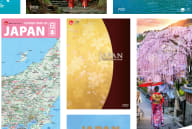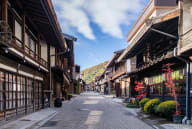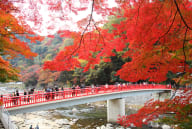
Oita Steam, soak, savour—nature and culture intertwined
A Culinary Journey in Oita
Oita Prefecture, located on the eastern coast of the Kyushu region, is renowned for its natural hot springs, stunning landscapes, and diverse culinary delights. Blessed with a mild climate and fertile lands, Oita produces a bounty of fresh ingredients that form the backbone of its rich and varied food culture.
Oita's rich agricultural tradition is reflected in its vast array of products. The prefecture is renowned for its high-quality shiitake mushrooms, Kabosu citrus, and barley-fed Bungo beef. Its coastline is teeming with a variety of fresh seafood, including the prized Seki mackerel and fugu (pufferfish). Local dishes such as Toriten (tempura chicken) and Dango-jiru (dumpling soup) showcase these ingredients, offering a taste of Oita's culinary heritage.
Oita’s food culture is steeped in history, reflecting a harmonious blend of influences from both the land and the sea. The prefecture has a long-standing tradition of fermentation, producing unique products like barley miso and Kabosu-based condiments. Known for its diverse tourist attractions, such as the tranquil Yufuin and Beppu hot springs, historic Usa Jingu Shrine, and the popular Sanrio Harmony Land, Oita showcases culinary traditions that reflect the prefecture’s rich history and vibrant culture.
Savour Oita's classic favourites or uncover inventive dishes as you immerse yourself in its distinctive flavours and traditional food culture.
Ryukyu (Flavoured sashimi)

What it is (ingredients)
Ryukyu is a specialty dish from Oita, featuring thinly sliced sashimi of local catch, typically including fresh fish such as yellowtail, squid, and mackerel. It's delicately seasoned with soy sauce, sake, mirin, sesame, and ginger, enhancing the flavours of the seafood. With the sauce fully absorbed, it’s delightful served over freshly cooked rice, or combined with hot water or soup stock to make a comforting bowl of Ochazuke (rice with tea or broth).
History/Origin
Originating from Oita's rich fishing traditions and vibrant culinary culture, Ryukyu showcases the prefecture's expertise in preparing and presenting seafood. “Ryukyu” was originally the old name of Okinawa prefecture. It is named “Ryukyu”, as it is said that this cooking method was introduced to Oita from Okinawa a long time ago. The dish evolved to highlight the freshness of the catch and the prefecture's unique flavour profiles, making it a beloved choice among locals and visitors alike.
Where You Can Eat
Ryukyu can be served at traditional Japanese restaurants along Oita's coast, where fishermen often bring in the day's catch. Restaurants in Beppu and Oita City also offer variations of Ryukyu, ensuring that you can savour this local delicacy in diverse settings.
When to Eat
Ryukyu is enjoyed year-round, especially during summer when the seafood is abundant and freshest. Whether as an appetizer or a main course, Ryukyu's refreshing flavours make it ideal for warm-weather dining or as part of a leisurely meal with friends and family.
Experience the dish that highlights Oita's coastal bounty and local creativity, designed to delight your taste buds.
Tori-ten (Chicken tempura)

What it is (ingredients)
Tori-ten, a beloved dish in Oita, consists of tender chicken pieces coated in a light, crispy tempura batter. It is often served with squeezed Kabosu (citrus fruit) and vinegared soy sauce or ponzu sauce with mustard paste, showcasing Oita’s fresh poultry, delicate seasoning, and expert frying technique.
History/Origin
Originating in the prefecture's first restaurant in Beppu City during the Showa period (1926 - 1989), Tori-ten emerged as a popular chicken cuisine, as it cooks faster than traditional fried chicken and has a crispy and soft coating. The tradition of using locally sourced chicken, paired with the ever-more refined art of tempura frying has evolved over centuries, making Tori-ten a staple in Oita's culinary landscape. The people of Oita are known for their love of chicken, and in the past, they ranked first in the country for per-household consumption.
Where You Can Eat
While Tori-ten is readily available across Oita Prefecture, Oita City's restaurants and Izakaya (Japanese-style dining bars) offer some of the most authentic and delightful dining experiences for this dish. These establishments pride themselves on using fresh, local ingredients and maintaining the traditional frying techniques that define Tori-ten's flavour and texture.
When to Eat
Tori-ten is best enjoyed as a light meal or appetizer throughout the year. However, it is particularly satisfying during Oita's vibrant summer festivals or as a comforting treat during chilly winter months. Be it a quick bite or a shared dish among friends, Tori-ten embodies Oita's commitment to culinary excellence and local pride.
Delight in the crispy goodness of Tori-ten, where Oita's rich culinary heritage meets the artistry of tempura frying.
Dango-jiru (Dumpling soup)

What it is (ingredients)
Dango-jiru is a soup from Oita, featuring dumplings made of wheat flour, often stewed with hearty vegetables such as cabbage, carrots, and mushrooms. The broth typically includes dashi and soy sauce, creating a savoury base that complements the dumplings.
History/Origin
Originating from rural Oita, Dango-jiru emerged as a nourishing meal for farmers and locals seeking warmth during cold winters. Long ago, when rice was in short supply, it was eaten daily as a replacement. Its humble beginnings reflect Oita's farmer’s traditions and resourceful use of local ingredients, showcasing a rustic yet flavourful soup that has endured through generations. Generally, the word "Dango" is used for spherical dumplings, but in Oita, they are hand-stretched like noodles. It is said that the name "Dango" came from the fact that they are rolled up and left to rest during the making process.
Where You Can Eat
While Dango-jiru is traditionally enjoyed in homes across Oita Prefecture, you can find authentic renditions in local eateries, from casual diners to traditional restaurants. Look for restaurants in Oita City or Beppu which specialize in local cuisine for a taste of this comforting dish.
When to Eat
Dango-jiru is particularly comforting during the colder months of autumn and winter, when its warming qualities are most appreciated. As a starter or a main course, this dumpling soup allows you to savour the essence of Oita's countryside and culinary traditions.
Experience the soul-warming flavours of Dango-jiru, a testament to Oita's agricultural roots and culinary ingenuity































































